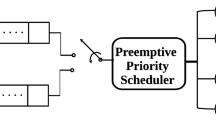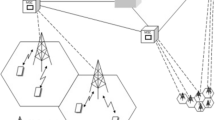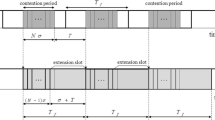Abstract
This study presents models for management of voice and data traffic and new algorithms, which use call admission control as well as buffer management to optimise the performance of single channel systems such as wireless local area networks in the presence of mobile stations. Unlike existing studies, the new approach queues incoming voice packets as well as data packets, and uses a new pre-emption algorithm in order to keep the response time of voice requests at certain levels while the blocking of data requests is minimised. A new performance metric is introduced to provide uncorrelated handling of integrated services. Queueing related issues such as overall queue capacity, individual capacities for voice and data requests, the probability of blocking, and effects of waiting time on overall quality of service are considered in detail. Analytical models are presented and the results obtained from the analytical models were validated using discrete event simulations.








Similar content being viewed by others
Explore related subjects
Discover the latest articles, news and stories from top researchers in related subjects.References
Abd El-atty, S. M., & Gharsseldien, Z. M. (2015). Measuring QoS metrics in femto/macro cellular networks with CAC policy. International Journal of Wireless Information Networks, 22(3), 240–251.
Alsamhi, S. H., Rajput, N. S. (2016) Implementation of call admission control technique in HAP for enhanced QoS in wireless network deployment. Telecommunication Systems, 63(2), 141–151. doi:10.1007/s11235-015-0108-4.
Banks, J., & Nelson, B. (2010). Discrete-event system simulation. NJ: Prentice Hall.
Bonald, T., & Feuillet, M. (2012). Performance of CSMA in multi-channel wireless networks. Queueing Systems, 72(1–2), 139–160.
Brouzioutis, C., Vitsas, V., & Chatzimisios, P. (2010) Studying the impact of data traffic on voice capacity in IEEE 802.11 WLANs. In: Communications (ICC), 2010 IEEE International Conference on, pp. 1–6.
Carvalho, G., Martins, V., Francês, C., Costa, J., & Carvalho, V. (2008). Technical communication: Performance analysis of multi-service wireless network: An approach integrating CAC, scheduling, and buffer management. Computers & Electrical Engineering, 34(4), 346–356.
Chakka, R. (1998). Spectral expansion solution for some finite capacity queues. Annals of Operations Research, 79, 27–44.
Enver, E., Gemikonakli, O., Koçyigit, A., & Gemikonakli, E. (2013). A hybrid approach to minimize state space explosion problem for the solution of two stage tandem queues. Journal Network and Computer Applications, 36(2), 908–926.
Ferng, H., & Tsai, Y. (2005). Using priority, buffering, threshold control, and reservation techniques to improve channel-allocation schemes for the GPRS system. IEEE Transactions on Vehicular Technology, 54(1), 286–306.
Gemikonakli, O., Ever, E., & Kocyigit, A. (2009). Approximate solution for two stage open networks with Markov-modulated queues minimizing the state space explosion problem. Journal of Computational and Applied Mathematics, 223(1), 519–533.
Hamidi-Sepehr, F., Pfister, H., & Chamberland, J. F. (2015). Delay-sensitive communication over fading channels: Queueing behavior and code parameter selection. IEEE Transactions on Vehicular Technology, 64(9), 3957–3970.
Hu, J., Min, G., Jia, W., & Woodward, M. E. (2012). Comprehensive QoS analysis of enhanced distributed channel access in wireless local area networks. Information Sciences, 214, 20–34.
Wang, J., Zeng, Q. A., & Agrawal, D. (2003). Performance analysis of a preemptive and priority reservation handoff scheme for integrated service-based wireless mobile networks. IEEE Transactions on Mobile Computing, 2(1), 65–75.
Khatib, I. A. (2003) Performance analysis of wireless lan access points. Ph.D. thesis, Department of Microelectronics and Information Technology, Royal Institute of Technology.
Kryvinska, N. (2008). An analytical approach for the modeling of real-time services over IP network. Mathematics and Computers in Simulation, 79(4), 980–990.
Law, A. (2007). Statistical analysis of simulation output data: thepractical state of the art. Proceedings of the 39th conference on Winter simulation, WSC ’07 (pp. 77–83). Piscataway, NJ: IEEE Press.
Li, T., Leith, D., & Malone, D. (2011). Buffer sizing for 802.11-based networks. IEEE/ACM Transactions on Networking, 19, 156–169.
Martorell, G., Femenias, G., & Riera-Palou, F. (2015). Non-saturated IEEE 802.11 networks. A hierarchical 3D Markov model. Computer Networks, 80, 27–50.
Medepalli, K., Gopalakrishnan, P., Famolari, D., Kodama, T. (2004). Voice capacity of IEEE 802.11b, 802.11a and 802.11g wireless LANs. In: GLOBECOM, (pp. 1549–1553).
Mitrani, I. (1998). Probabilistic modelling. Cambridge: Cambridge University Press.
Munir, K., Lagrange, X., Bertin, P., Guillouard, K., & Ouzzif, M. (2014). Performance analysis of mobility management architectures in cellular networks. Telecommunication Systems, 59(2), 211–227.
Dini, P., Portols-Comeras, M., Nin-Guerrero, J., & Mangues-Bafalluy, J. (2011). Experimental characterization of VoIP traffic over IEEE 802.11 wireless LANs. Rijeka: In Tech.
Pavlidou, F. (1994). Two-dimensional traffic models for cellular mobile systems. IEEE Transactions on Communications, 42(234), 1505–1511.
Qing, H., & Chakravarthy, S. R. (2012). Analytical and simulation modeling of a multi-server queue with Markovian arrivals and priority services. Simulation Modelling Practice and Theory, 28, 12–26.
Rabta, B. (2013). A hybrid method for performance analysis of G/G/m queueing networks. Mathematics and Computers in Simulation, 89, 38–49.
Rejeb, S. B., Nasser, N., & Tabbane, S. (2014). A novel resource allocation scheme for LTE network in the presence of mobility. Journal Network and Computer Applications, 46, 352–361.
Tarek, B., & Nidal, N. (2009). Efficient call admission control scheme for 4G wireless networks. Wireless Communications and Mobile Computing, 9(4), 489–499.
Wang, W., Soung-Chang, L., & Li, V. K. (2005). Solutions to performance problems in voIP over a 802.11 wireless LAN. IEEE Transactions on Vehicular Technology, 54(1), 366–384.
Winands, E. M. M., Denteneer, T. J. J., Resing, J. A. C., & Rietman, R. (2005). A finite-source queuing model for the IEEE 802.11 DCF. European Transactions on Telecommunications, 16(1), 77–89.
Zahed, S., Awan, I., & Cullen, A. J. (2013). Analytical modeling for spectrum handoff decision in cognitive radio networks. Simulation Modelling Practice and Theory, 38, 98–114.
Zhai, H., Kwon, Y., & Fang, Y. (2004). Performance analysis of IEEE 802.11 MAC protocols in wireless LANs: Research articles. Wireless Communications and Mobile Computing, 4(8), 917–931.
Author information
Authors and Affiliations
Corresponding author
Rights and permissions
About this article
Cite this article
Gemikonakli, E., Ever, E., Mapp, G. et al. Admission control and buffer management of wireless communication systems with mobile stations and integrated voice and data services. Telecommun Syst 65, 663–675 (2017). https://doi.org/10.1007/s11235-016-0259-y
Published:
Issue Date:
DOI: https://doi.org/10.1007/s11235-016-0259-y




